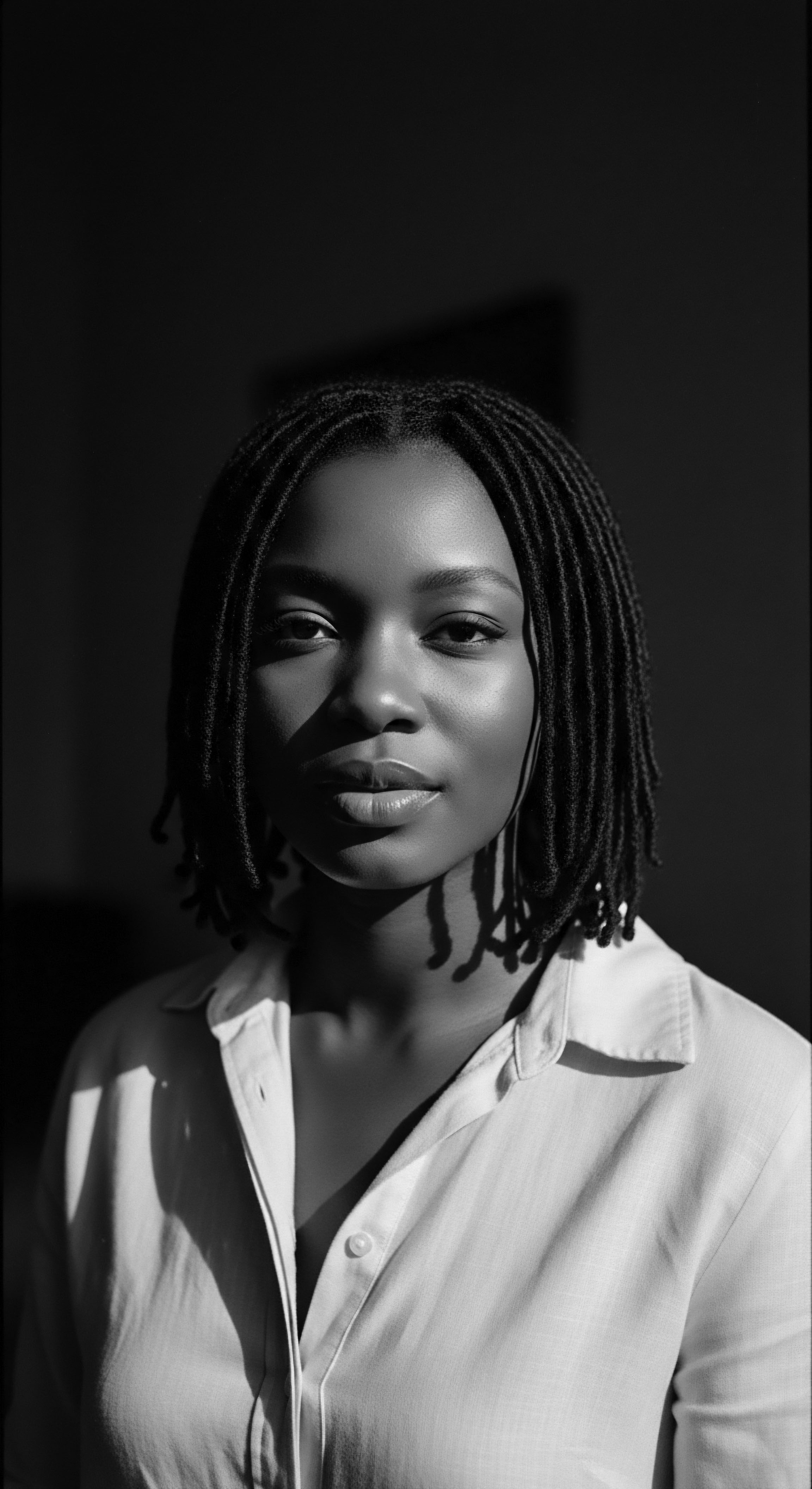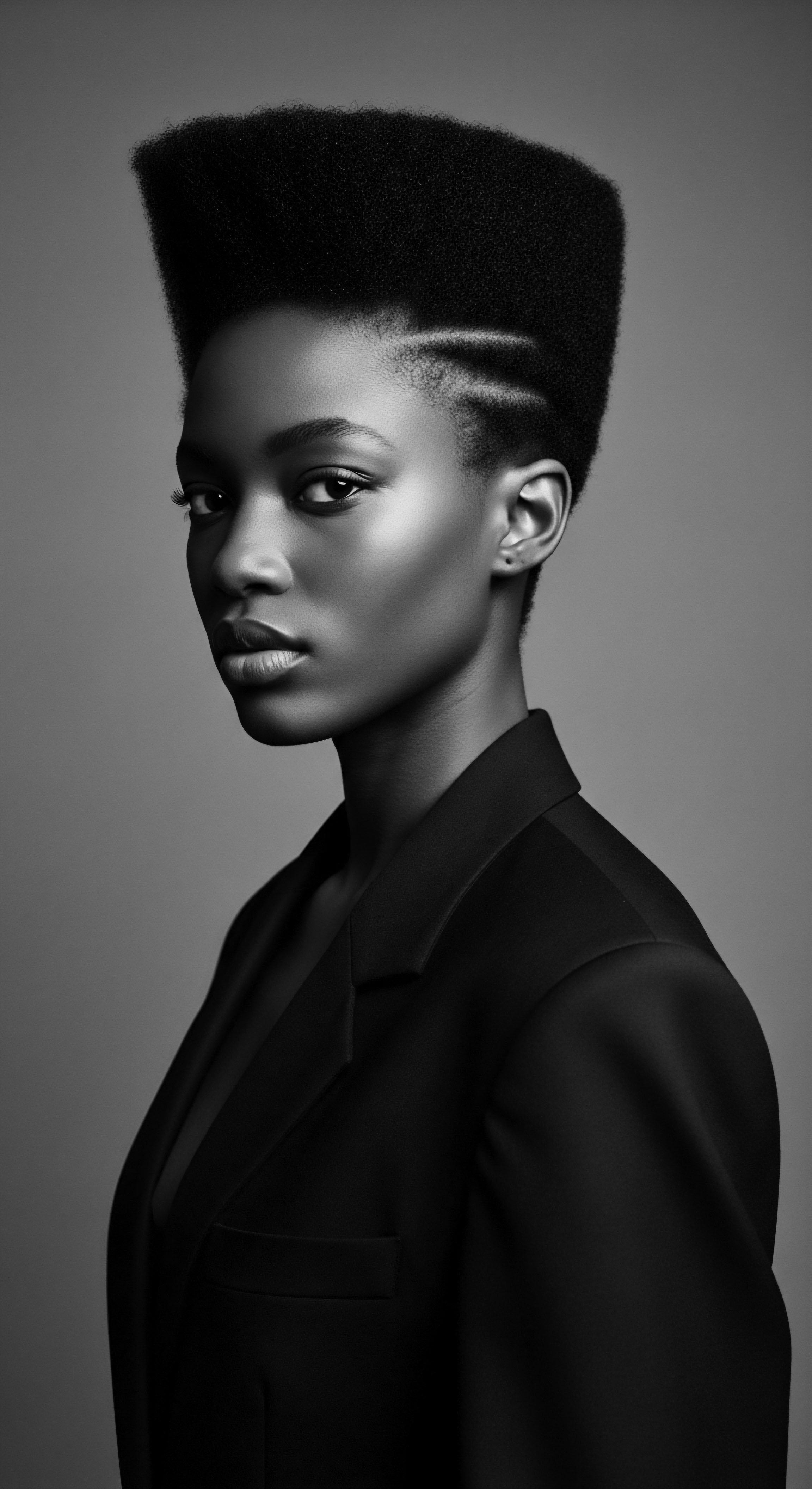
Roots
To journey into the heart of textured hair care traditions is to trace whispers from the very wellspring of our collective memory. It is a mindful walk through ancestral landscapes, where every coil, every curl, held not just biological significance but also profound communal resonance. When we ask how ancient community rituals shaped the care of textured hair, we are not simply asking about historical practices.
We are seeking the deep, intricate connections between individual strands and the enduring spirit of community, a profound testament to heritage that lives in us all. This exploration begins by acknowledging hair not as a mere adornment, but as a living record, a scroll upon which identity, status, and spiritual beliefs were written in ancient civilizations.
From the earliest known moments, particularly across the African continent, hair served as a potent visual language. It communicated affiliations, marked rites of passage, and signified social standing. The very act of hair styling was often a communal endeavor, a gathering that fortified bonds and transmitted wisdom across generations. These sessions were rich with shared stories, lessons, and the rhythmic movements of hands shaping, braiding, and oiling.
A profound respect for hair, often viewed as a conduit to the divine or ancestral realm due to its proximity to the head, guided these practices. This reverence meant that care was more than a cosmetic routine; it was a sacred duty, a continuation of cultural legacy.

The Sacred Strand Its Structure and Early Care
The unique helical structure of textured hair, with its elliptical follicle shape, allows for remarkable elasticity and volume, yet also presents specific needs for moisture retention and careful handling. Our ancient forebears understood this intuitively, observing the natural inclinations of their hair and devising methods that worked in harmony with its biology. They recognized its tendency towards dryness, its glorious ability to hold intricate styles, and its need for protective measures against the elements. This observational science, honed over millennia, formed the bedrock of their care regimens.
- Moisture ❉ Ancient communities often utilized natural oils and plant extracts to lubricate and protect the hair shaft, guarding against arid climates and environmental stressors.
- Protection ❉ Styling techniques like braiding, twisting, and coiling served to shield delicate strands from damage, allowing for length retention and overall hair health.
- Cleanse ❉ While water might have been scarce in some regions, methods of cleansing involved herbal washes or dry dusting with clays, followed by rich applications of conditioning agents.
Consider the earliest historical records, found in diverse African civilizations. Archaeological evidence from ancient Egypt, for instance, shows elaborate wigs and braids signifying social status and religious beliefs. The Kingdom of Kush similarly revealed intricate beadwork within hairstyles, demonstrating a long history of hair as a medium for creative expression and communal identification. These early expressions were not happenstance; they represented a deep understanding of textured hair’s capabilities and how its presentation could mirror the collective spirit.
Ancient care for textured hair was a communal knowledge, passed through generations, recognizing the strand as a canvas for identity and a receiver of ancestral energy.
The materials employed in these early care rituals were drawn directly from the earth and local environments. Butters from shea or mango trees, various plant oils, clays, and aromatic resins became the earliest formulations. These ingredients were chosen not only for their conditioning properties but also for their symbolic connection to the land and its abundance.
Their application often occurred during communal grooming sessions, strengthening familial ties and acting as a vessel for shared cultural narratives. The act of tending to one another’s hair became an extension of caring for the community itself.
The ways in which textured hair was classified and understood in ancient times differed greatly from modern systems. Rather than scientific typologies, classifications were more fluid, connected to one’s social role, age, marital status, or tribal affiliation. A particular style or adornment immediately communicated specific information about the wearer to those within the community. This deep social coding of hair meant that its care was never a solitary activity, nor was it solely about aesthetics; it was always about belonging, about conveying one’s place within the societal fabric.

Ritual
The evolution of textured hair care from basic necessity to an intricate system of communal rituals speaks volumes about its profound place in ancient societies. These were not random acts of grooming, but rather deliberate, ceremonial observances, often imbued with spiritual meaning and social directives. The hair, sitting atop the head, was often seen as the highest point of the body, a spiritual antenna, a direct connection to higher realms and ancestral spirits. This elevated perception meant that its care was elevated to a sacred practice.
Communal hair care sessions served as powerful social anchors, spaces where generations connected, stories unfolded, and cultural values were imparted. Picture a gathering where grandmothers, mothers, and daughters would spend hours on each other’s heads, their hands moving with practiced grace, crafting styles that spoke volumes. These were moments of intimacy, trust, and profound cultural transmission. The time commitment alone for intricate styles meant that these gatherings were not fleeting; they demanded presence, patience, and shared purpose.

Beyond Adornment How Did Styling Become Sacred?
Hair styling was rarely a casual affair. For many ancient African communities, the creation of specific hairstyles was a deeply symbolic act. Styles could mark a person’s passage through different life stages ❉ birth, coming of age, marriage, motherhood, or even mourning. They could also signify status within a community, a person’s wealth, or their family lineage.
The very act of braiding, twisting, or coiling became a form of storytelling, a non-verbal language understood by all who shared that particular heritage. The communal aspect of hair care meant that these stories were collectively remembered, reinforcing a shared identity.
Hair rituals were communal gatherings, transforming individual care into a shared celebration of life, status, and ancestral connection.
Consider the significance of communal braiding circles. These were not simply salons; they were living libraries of tradition. As hands worked, elders would recount ancestral tales, instruct younger generations on the properties of various herbs and oils, and discuss community matters.
This continuous stream of oral tradition ensured that the wisdom of hair care, inextricably linked to broader cultural knowledge, continued from one generation to the next. This shared activity reinforced social bonds and a collective sense of belonging, making hair care a truly social act.

Cultural Toolkits and Ancient Regimens
The tools and substances utilized in ancient textured hair care were testament to indigenous ingenuity and a deep knowledge of the natural world. Far from today’s mass-produced products, these were often locally sourced, handcrafted items and formulations.
Traditional implements often included:
- Combs and Picks ❉ Carved from wood or bone, these tools were designed to navigate the density and curl patterns of textured hair, often serving ceremonial purposes or signifying status.
- Adornments ❉ Beads, cowrie shells, precious metals, and natural fibers were woven into hairstyles, adding layers of meaning and often acting as protective amulets.
- Herbal Poultices ❉ Pastes made from various plants and clays were applied for cleansing, conditioning, and to provide sun protection.
A prime example of such enduring practices comes from the Himba people of Namibia. Their renowned “otjize” paste, a blend of ochre, butterfat, and aromatic resin, is applied daily to both skin and hair. This practice is far more than cosmetic; it offers practical protection against the harsh desert environment, shielding from UV rays and helping maintain hygiene where water is scarce (Toine IJsseldijk, n.d.). Beyond its practical benefits, the reddish hue of otjize symbolizes blood, the essence of life, and the earth’s rich color, signifying a profound connection to their ancestral land.
Women begin using otjize from a young age, and its application becomes an essential daily ritual passed down through generations, making it a powerful symbol of their cultural resilience and identity (IJsseldijk, n.d.; The Guardian Nigeria News, 2022). Himba hairstyles reflect marital status, age, wealth, and rank within the group, with hair braiding often a communal activity (INFRINGE, n.d.). This case shows a clear communal, ritualistic, and highly meaningful approach to textured hair care.
The meticulous preparation of these natural substances was often a ritual in itself. The gathering of herbs, the grinding of ochre, the rendering of animal fats—each step was carried out with intentionality, recognizing the life-giving properties of these gifts from the earth. The communal aspect of this preparation further strengthened the bond between the people and their environment, viewing these resources not simply as commodities but as sacred elements to be respected and carefully utilized. The continuity of these practices, passed down through oral traditions and hands-on teaching, speaks to their deep efficacy and their undeniable role in sustaining cultural identity across many centuries.

Relay
The understanding of textured hair care traditions as living archives of community ritual moves beyond simple description, calling for a deeper analysis of their historical, cultural, and even biological underpinnings. We must view these practices not as static remnants of a distant past, but as dynamic systems that adapted, persisted, and continue to transmit profound truths about self, society, and spirit. The resilience of these customs, often against formidable external pressures, truly illuminates their foundational place within the heritage of Black and mixed-race communities.
Ancient communal hair practices were deeply intertwined with societal structures. The meticulous construction of hairstyles, often requiring hours or even days, naturally invited collective participation. This shared labor was not merely efficient; it was a mechanism for reinforcing social cohesion.
It provided a setting for elders to impart wisdom, for peers to share experiences, and for younger generations to absorb cultural knowledge through observation and participation. This continuous transmission meant that the very act of hair grooming became a cultural scaffold, upholding shared identity.

What Did Hair Communicate in Ancient Societies?
Beyond aesthetics, textured hair in ancient societies was a powerful medium of non-verbal communication. Every curl, braid, and adornment conveyed specific messages within the community, often acting as a visual resume of an individual’s life and standing. This complex semiotics of hair served to reinforce social order and connection.
Consider these aspects of hair’s communicative power:
- Social Markers ❉ Hairstyles frequently indicated an individual’s age, marital status, wealth, or specific tribal affiliation. For instance, among the Fulani people of West Africa, elaborate hairstyles adorned with beads and cowrie shells could signify everything from fertility to social status.
- Spiritual Conduits ❉ Many African cultures believed the head to be the seat of the soul and the closest point to the divine. Hair, therefore, served as a spiritual antenna. Rituals involving hair, such as ceremonial shaving or specific styling before significant life events, aimed to connect individuals with ancestors or protective spirits.
- Historical Records ❉ In some traditions, specific braiding patterns or the incorporation of certain materials could signify historical events, community achievements, or even individual life stories, acting as a living chronicle.
The deep cultural symbolism of hair is also documented in the practices of the Zulu and Xhosa peoples of South Africa. Here, girls learn intricate weaving techniques from their mothers and grandmothers, a tradition considered vital for maintaining cultural identity and strengthening family bonds. A 2020 study in South Africa revealed that 85% of rural Zulu and Xhosa women acquired traditional weaving techniques directly from their mothers or grandmothers, highlighting the enduring power of intergenerational transfer of this heritage. This illustrates how traditional hair care is not simply about appearance; it actively preserves and transmits cultural identity through shared practical activity.

How Does Modern Science Echo Ancestral Wisdom?
The contemporary scientific understanding of textured hair biology often aligns with ancestral practices, providing a compelling validation of long-held traditional knowledge. The recognition of hair’s porous nature, its susceptibility to moisture loss, and the importance of protective styling were implicitly understood by ancient practitioners. They intuitively developed solutions that science now explains at a molecular level.
| Traditional Practice/Ingredient Application of natural butters (e.g. shea, cocoa) and plant oils (e.g. coconut, olive) |
| Modern Scientific Understanding/Benefit These emollients contain fatty acids and vitamins that seal the cuticle, reduce protein loss, and provide lubrication to prevent breakage. They mimic the scalp’s natural sebum. |
| Traditional Practice/Ingredient Protective hairstyles (braids, twists, cornrows) |
| Modern Scientific Understanding/Benefit Minimizes manipulation of individual strands, reducing mechanical stress and breakage. Protects ends from environmental exposure, thus aiding in length retention. |
| Traditional Practice/Ingredient Use of natural clays and herbal washes |
| Modern Scientific Understanding/Benefit Clays (like rhassoul) gently cleanse without stripping natural oils, while herbs often possess anti-inflammatory, antimicrobial, or conditioning properties beneficial for scalp health. |
| Traditional Practice/Ingredient Communal grooming as a social ritual |
| Modern Scientific Understanding/Benefit Reduces stress through social connection, offers shared knowledge transfer, and strengthens mental well-being, which has indirect positive effects on overall health, including hair health. |
| Traditional Practice/Ingredient The synergy between ancient methods and contemporary science underscores the timeless wisdom embedded in textured hair heritage. |
The continuity of these traditional methods, adapted and refined over time, demonstrates a practical wisdom that predates formal scientific inquiry. The meticulous care of the scalp, for example, a common element in ancient African hair rituals, is now understood as fundamental to healthy hair growth cycles. Ingredients like baobab oil or moringa, long used in African communities, are now recognized for their rich vitamin and antioxidant profiles that nourish both scalp and strand. This convergence of ancestral observation and scientific validation underscores the enduring efficacy of heritage-based practices.

Hair as a Symbol of Resistance and Resilience
The transatlantic slave trade presented a devastating assault on the cultural identities of enslaved Africans, often beginning with the forced shaving of heads upon arrival. This act was a deliberate attempt to strip individuals of their identity, severing their connection to cultural heritage and community markers embedded in their hair. Yet, even under such brutal conditions, the resilience of textured hair traditions persisted.
Enslaved Africans, in covert ways, maintained and adapted their hair care rituals, using whatever materials were available, like butter, ash, or even grease, to maintain their hair. This quiet defiance transformed hair into a symbol of resistance, a link to a stolen past, and a silent assertion of enduring identity (Byrd & Tharps, 2001).
The ongoing significance of hair as a marker of Black and mixed-race identity is evident in movements throughout history. From the Afro of the Civil Rights era, representing racial pride and solidarity, to the contemporary natural hair movement, reclaiming ancestral textures, hair continues to serve as a powerful medium for self-expression and cultural affirmation. The collective experiences of hair discrimination throughout history further underscore the deep meaning attributed to textured hair, making its care and styling not merely a personal choice but a socio-political statement, a direct connection to a legacy of defiance and beauty.

Reflection
The journey through ancient community rituals and their shaping of textured hair care traditions reveals a tapestry woven with ingenuity, reverence, and an unbreakable communal spirit. It is a story whispered through generations, imprinted on every curl and coil, reminding us that hair is never simply strands of protein. It is a living, breathing archive of identity, a repository of ancestral wisdom, and a profound statement of enduring heritage.
The care given to textured hair in ancient times was a sacred dialogue between individual, community, and the natural world. This practice reinforced social structures, communicated complex meanings, and sustained cultural memory against the tides of time.
Roothea’s ‘Soul of a Strand’ ethos finds its deepest resonance in these historical echoes. It acknowledges that the vitality of our hair today is inextricably linked to the legacy of those who came before us, who understood its capabilities, its needs, and its power long before modern science could articulate it. Our contemporary routines, whether consciously or not, carry fragments of these ancient rituals, from the oils we choose to the protective styles we adorn. To connect with our textured hair heritage is to honor this unbroken lineage, to recognize the profound wisdom held within the practices passed down through time.
It is a call to view our hair not as something to be managed or conformed, but as a cherished inheritance, a source of strength, and a vibrant expression of who we were, who we are, and who we are becoming. Our hair remains an unbound helix, ever reaching, ever connected to its source.

References
- Byrd, A. D. & Tharps, L. L. (2001). Hair Story ❉ Untangling the Roots of Black Hair in America. St. Martin’s Press.
- INFRINGE. (n.d.). Himba Hair Rituals. Retrieved from INFRINGE Magazine.
- Johnson, T. A. & Bankhead, T. (2014). Hair It Is ❉ Examining the Experiences of Black Women with Natural Hair. Open Journal of Social Sciences, 2(1), 86-100.
- Opare-Darko, F. M. & Dennis, A. (2023). Body adornment among the Krobo in Ghana ❉ Hair, a crowning glory. Journal of African Historical and Cultural Arts, 3(2), 22-38.
- The Guardian Nigeria News. (2022, January 27). Otjize ❉ The Red Beauty Miracle Of The Himba People. Retrieved from The Guardian Nigeria.
- Toine IJsseldijk. (n.d.). The Himba Tribe ❉ Otjize. Retrieved from Toine IJsseldijk Photography.
